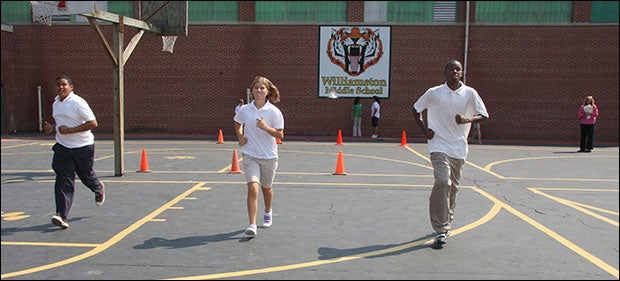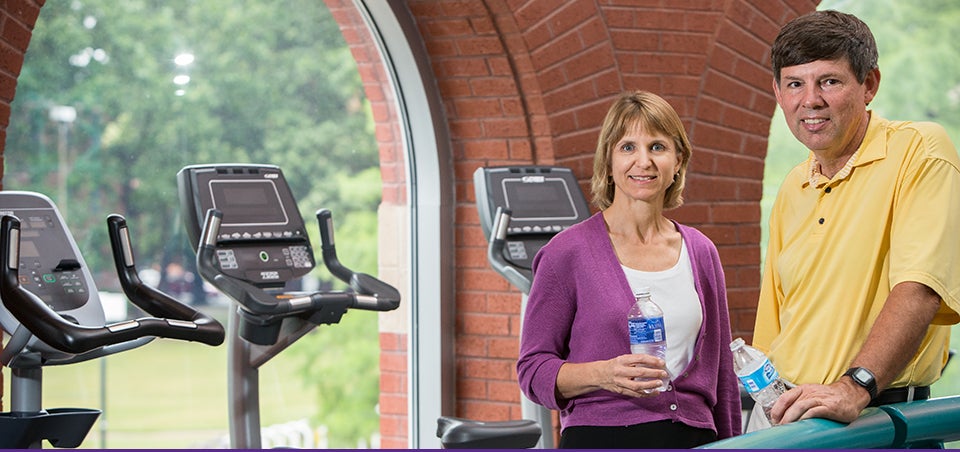EMPOWERING YOUTH
Childhood obesity no match for ECU intervention program
When seventh-grade science teacher and East Carolina University alumnus Tim Hardison learned his fellow Martin County residents had the shortest life expectancy in the state, he wanted to know why. So he dug a little deeper and discovered his rural, economically challenged county also had exceptionally high rates of diabetes and cardiovascular disease – illnesses often linked to obesity.
Hardison measured the heights and weights of his science students and had each one calculate their BMI (body-mass index). More than half were overweight or obese.
Unable to find a suitable curriculum to help them achieve healthy weight, Hardison created one. Then he implemented it using personal funds and a little financial support from local businesses. He based the program on a behavioral change theory and used the “body systems” approach that the seventh-grade science course was already organized around. His focus: simple lifestyle choices his students could make to improve their health. That was in 2007.

Middle schoolers observe as a sugar-free soda floats while the regular version sinks to the bottom. (Contributed photo)
Eight years later, the ECU pediatric obesity intervention team Hardison is now part of has received funding to help gradually expand that curriculum into dozens of schools while preparing for a potential large-scale implementation.
MATCH Wellness – Motivating Adolescents with Technology to CHOOSE Health – aims to motivate and empower middle-schoolers to take personal responsibility for their health. Currently taught in 17 schools throughout North and South Carolina, the program was recently awarded $470,000 by the North Carolina chapter of the U.S. Department of Agriculture’s Supplemental Nutrition Assistance Program Education (SNAP-Ed) organization to gradually increase coverage to as many as 100 North Carolina schools over the next three years.
Another $750,000 from the Blue Cross Blue Shield Foundation of North Carolina will simultaneously help the team gear up for replication in 10 times that many schools when the opportunity arises. Administrators are already working to hire additional staff, stock up on resources and refine their infrastructure so they’ll be poised for greater capacity.
A model program
Hardison said seeing the initial BMI data on his inaugural student group was a major motivation to develop MATCH. “I knew many of those kids were at risk for obesity-related diseases – and shortened lives,” he said. “But I also knew those outcomes are mostly preventable when people have the knowledge to make good choices. I thought, ‘I can’t change the country, but I can do something to help these 110 kids.’”
When he measured those students again at the end of the school year, nearly three-quarters of the overweight and obese students had improved their BMIs. And thus, MATCH Wellness was born.
The following year, Hardison convinced the N.C. Joint Legislative Task Force on Childhood Obesity to fund the program at his school, and he sought help from Dr. Suzanne Lazorick, pediatrican and child obesity expert with ECU’s Pediatric Healthy Weight Research and Treatment Center. The N.C. State Board of Education selected MATCH as a model program for North Carolina and kicked in funding for several more schools. In 2009 Hardison left the classroom to join ECU as MATCH program director.
Over the past eight years, unwavering determination from the MATCH team and about $2 million in grants from various foundations – especially the Blue Cross Blue Shield Foundation of North Carolina – have enabled 5,600 students to benefit from the program.
“The idea is to arm these kids with a knowledge base that will help them modify their behavior and make healthy choices so they can successfully manage their weight, prevent disease and optimize health,” Hardison said.
MATCH Wellness is currently under consideration by the USDA for a pilot expansion into eight southeastern states. It’s the only middle-school-based obesity intervention program to receive approval as an independently “research tested” program by the Center for Training, Research and Translation, a group designated to evaluate programs for the U.S. Centers for Disease Control and Prevention.

Students at the former Williamston Middle School (now Riverside Middle) participated in a program developed by ECU alumnus Tim Hardison to target behaviors that could lead to a lifetime of obesity. (Contributed photo)
“The federal government wants programs that are evidence-based,” Lazorick said, “and MATCH is the only published, school-based, obesity intervention program in the country that shows beneficial long-term results. We’ve been consistently improving BMI in seven out of 10 overweight adolescents,” she said.
In addition to growing with a healthier weight, MATCH participants perform 24 percent better on their PACER Aerobic Fitness Test, considered by pediatricians to be the best independent predictor of academic performance in grades 3-8.
Follow-up studies of MATCH graduates at age 17 showed that 15 percent of overweight students had shifted to a healthy weight. And compared to a control group, MATCH veterans were half as likely to become obese between seventh and 11th grade.
“If students have improved their weight by age 17, they are very likely to maintain this healthy weight into adulthood,” Lazorick noted.
‘Heading off an epidemic’
According to the National Center for Health Statistics, childhood obesity has quadrupled in U.S. adolescents over the past 30 years. In eastern North Carolina the past two years, the rate of extreme obesity (weight above the 99th percentile) – at 9.3 percent – was double the national average.
It’s no surprise that the N.C. Institute of Medicine’s Task Force on Rural Health included MATCH Wellness as part of their recent suggested action plan.
“We’re heading off an epidemic,” Hardison said. “We have a much bigger problem than most people realize. If we don’t get a handle on this now, we’ll be in a world of hurt before long. We don’t even know all the problems these kids will have without intervention.”
An independent 2012 report by RTI International economist Lee Mobley estimated that implementing MATCH statewide over five years could save N.C. Medicaid up to $330 million in charges avoided by student participants alone.
Two years ago, Be Active North Carolina – a nonprofit committed to empowering North Carolinians to live healthy, active lives – calculated that a 3 percent conversion of overweight adults to healthy weight would save N.C. employers $3 billion annually in direct medical costs, lost productivity and workman’s compensation.
“MATCH has averaged a 15 percent conversion rate from overweight to healthy weight four years out, when teens are preparing to enter the workforce,” Hardison said. “Theoretically, we could save employers $15 billion per year, just for the cost of a few workbooks and some simple materials. That’s a $300 return for every dollar invested.”
Developing lifelong behaviors
MATCH lessons, designed to align with the N.C. Department of Public Instruction’s Common Core Standards, are delivered over a 16-week period across the whole seventh-grade curriculum “so as not to create extra work for already-overburdened teachers,” Hardison said.
Students might journal about a particular health behavior during language arts class, then calculate their BMIs in math. They engage in activities like “Re-think your drink,” in which they place two cans of a popular soft drink – one diet, one regular – in a bowl of water and watch the sugar-laden one sink as the diet one floats.
The web-based curriculum is chock-full of opportunities for students to identify their individual strengths and weaknesses, set personal goals, customize their own action plans, monitor their health behaviors and practice decision-making skills. And it provides teachers with real-time management of their students’ health data.
“I have lost a total of 10 pounds so far,” said one participant. “The MATCH program has really impacted my family. I have gotten them to start eating healthy foods, stop eating fast and fried foods every day, and do aerobic dances.”
Hardison said the key to MATCH’s effectiveness lies in the opportune age of its target audience. “Seventh-graders are just starting to feel independent and capable of influencing their own outcomes,” he said. “They’re developing lifelong behaviors and attitudes.
“Besides,” he added, “when you arm a 13-year-old with knowledge, they’ll become an agent of change within their household. You can’t shut them up.”
For more information on the MATCH Wellness program, visit http://www.matchwellness.org/.
